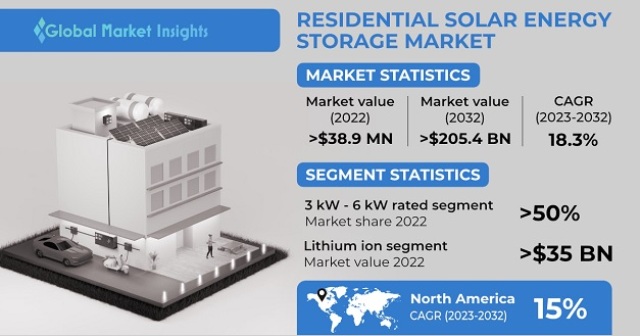The residential solar energy storage market will witness significant growth from 2023 to 2032.
The rising government incentives and favorable policies to encourage residential solar energy storage will lead to market expansion. The California Energy Commission released data on May 25, 2023, stating that more than 37 percent of the state’s electricity in 2021 came from sources that qualified for the Renewable Portfolio Standard (RPS), like solar and wind, an increase of 2.7 percent from 2020, says GM Insights.
The awareness of environmental concerns prompts homeowners to adopt sustainable energy solutions. Advancements in battery technologies enhance the efficiency and affordability of energy storage systems, making them more appealing. Fluctuating electricity prices encourage consumers to seek energy independence through stored solar power. Additionally, as grid resilience becomes crucial, energy storage mitigates power outages. Therefore, the residential solar energy storage market is empowering homeowners with clean energy and autonomy over their electricity consumption.
The overall residential solar energy storage market is classified based on power rating, technology, and region.
Based on the power rating, the > 6 kW segment will amass sizeable revenue from 2023 to 2032. These higher-capacity systems enable homeowners to store surplus solar energy for later use, increasing self-sufficiency and reducing reliance on the grid. As electricity needs grow and individuals aim to maximize their solar investments, these systems provide ample energy storage to meet household demands during peak hours or cloudy periods. The market’s shift towards larger power ratings reflects a desire for comprehensive energy solutions that ensure sustainable and cost-effective residential power consumption.
By technology, the lead acid segment of the residential solar energy storage industry will exhibit a noteworthy CAGR over 2023-2032. Despite newer battery technologies, lead-acid batteries remain popular due to their affordability and reliability. These systems efficiently store excess solar energy for nighttime or cloudy days, increasing energy self-sufficiency. While lithium-ion batteries often dominate discussions, lead-acid’s cost-effectiveness appeals to budget-conscious homeowners seeking sustainable energy solutions. As the market accommodates various preferences, lead-acid systems play a pivotal role in expanding the residential solar energy storage market.
Regionally, the Asia-Pacific residential solar energy storage market share will expand appreciably through 2032 due to the region’s rising energy costs, coupled with the region’s increasing energy consumption and environmental concerns, which are driving homeowners to seek sustainable alternatives. Government incentives and favorable policies further accelerate adoption. As countries like China, Japan, and Australia embrace renewable energy, residential solar energy storage systems provide a way to harness abundant sunlight and secure a stable power supply. The residential solar energy storage market growth in the Asia-Pacific underscores the region’s commitment to a greener future.

